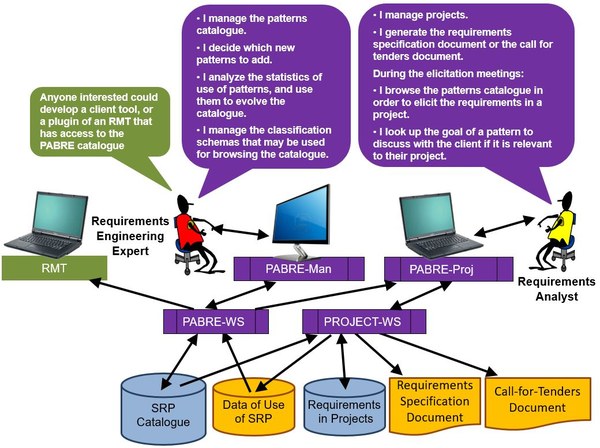PABRE
Framework
The PABRE system is not only a software system, but a framework that includes:
- a metamodel for SRP [1]
- a catalogue of Functional SRP (for the content management system domain) [2], Non-Functional SRP [3] and Non-Technical SRP [4]
- several tools for SRP management and use [5][6]
PhD thesis of Cristina Palomares [12] had as a goal the definition of the concept of SRP and a framework around this concept(PABRE framework) in order to facilitate the management and update of catalogues of SRPs that encapsulate reusable requirements knowledge, and to ease their use during the requirements elicitation and specification of a project in order to obtain SRSs of higher quality with a more effective RE process.
System
The PABRE system is composed of three subsystems: PABRE-MAN, PABRE-PROJ and PABRE-WS.

PABRE-MAN (webapp demo, slides, video older desktop version) is a tool that can be used by the requirement manager of the catalogue to maintain and evolve the software requirement patterns (SRP) catalogue. Its main functionalities are: patterns management, browsing, importation/exportation, printing and catalogue evolution. The current version is a desktop tool that connects to the catalogue database to manage the PABRE SRP catalogue.
PABRE-PROJ (webapp demo) is a tool that can be used by requirements analysts during the elicitation of requirements in a software development project, use of external software components, or acquisition of software systems. Its main functionalities are: project management, browsing, importation/exportation, requirements management document generation, call for tenders document generation and patterns use statistics exportation. Currently, there is also a web version of this tool, in a way that requirements analysts can access and edit software requirements projects from everywhere.
PABRE-WS (api) is a web service that provides access to the patterns catalogue. The idea is to allow existent requirement management tools to access the catalogue and support the implementation of new functionalities to use the patterns during requirements elicitation and documentation.
Publications
[1]. Franch, X., Palomares, C., Quer, C., Renault, S., De Lazzer, F.: A Metamodel for Software Requirement Patterns. In: Wieringa, R., Persson, A. (eds.) REFSQ 2010. LNCS, vol. 6182, pp. 85–90. Springer, Heidelberg (2010)
[2]. Palomares, C., Quer, C., Franch, X., Guerlain, C., Renault, S.: A Catalogue of Functional Software Requirement Patterns for the Domain of Content Management Systems. In: Requirements Engineering Track at 28th ACM SAC (RE-SAC), pp. 1260–1265. ACM
(2013)
[3]. Renault, S., Mendez, O., Franch, X., Quer, C.: A Pattern-based Method for building Requirements Documents in Call-for-tender Processes. Int. J. of Computer Science & Applications 6(5), 175–202 (2009)
[4]. Franch, X., Quer, C., Renault, S., Guerlain, C., Palomares, C.: Constructing and Using Software Requirements Patterns. In: Maalej, W., Thurimella, A.K. (eds.) Managing Requirements Knowledge, pp. 95–116. Springer (2013)
[5]. Palomares, C., Quer, C., Franch, X.: PABRE-Proj: Applying Patterns in Requirements Elicitation. In: IEEE International Requirement Engineering Conference (RE), pp. 332–333 (2013)
[6]. Palomares, C., Quer, C., Franch, X.: PABRE-Man: Management of a requirement patterns catalogue. 20th IEEE International Requirements Engineering Conference (RE 2011) pp. 341-342, Trento, Italy.
[7]. Costal, D., Franch, X., López, L., Palomares, C., Quer, C. On the Use of Requirement Patterns to Analyse Request for Proposal Documents. ER 2019, Salvador, Brazil
[8]. Cristina Palomares, Carme Quer, Xavier Franch. Requirements Reuse with the PABRE Framework. Requirements Engineering Magazine. The Magazine for RE Professionals from IREB. Issue 2014-01: Learning to fly.
[9]. Cristina Palomares, Carme Quer, Xavier Franch: Requirements Reuse and Patterns: A Survey. REFSQ 2014. https://doi.org/10.1007/978-3-319-05843-6_22
[10]. Palomares, C., Quer, C. & Franch, X. Requirements reuse and requirement patterns: a state of the practice survey. Empirical Software Engineering, 2017. https://doi.org/10.1007/s10664-016-9485-x
[11]. Franch,X., Palomares, C., Quer, C. Industrial Practices on Requirements Reuse: An Interview-based Study. REFSQ 2020, Pisa, Italy
[12]. Palomares, C. Definition and Use of Software Requirement Patterns in Requirements Engineering. Advisors: Xavier Franch, Carme Quer. UPC, July 2016.
Share: